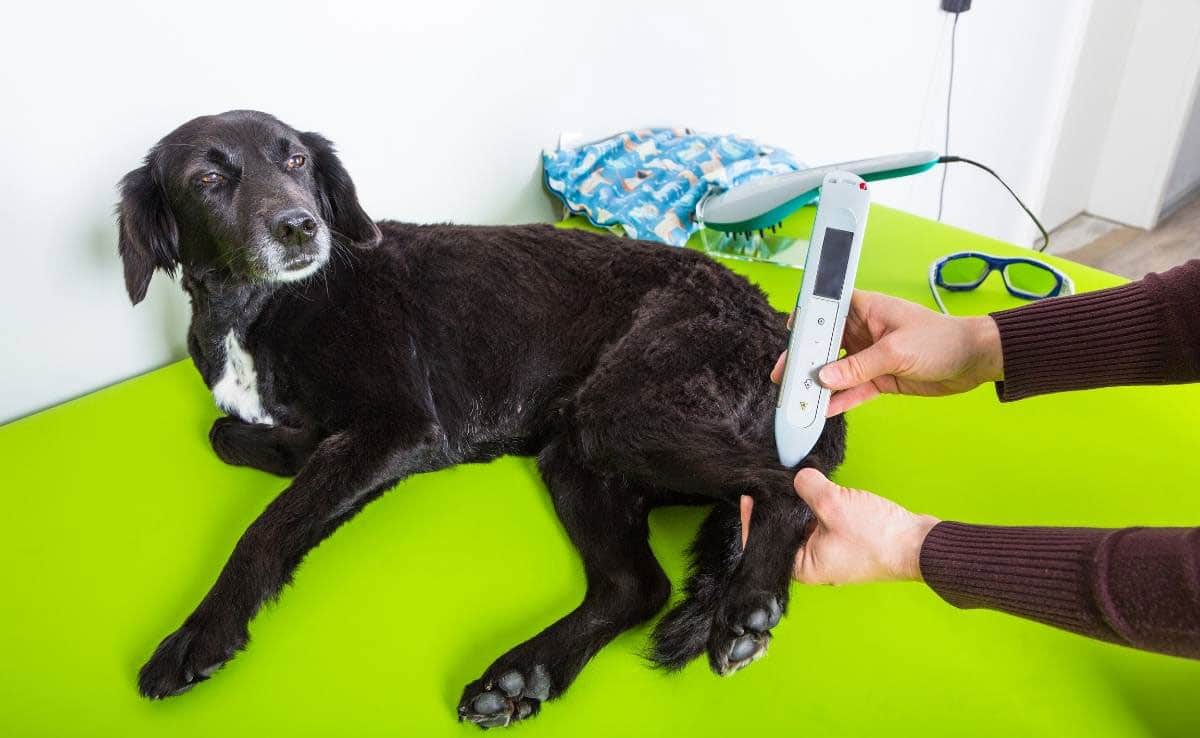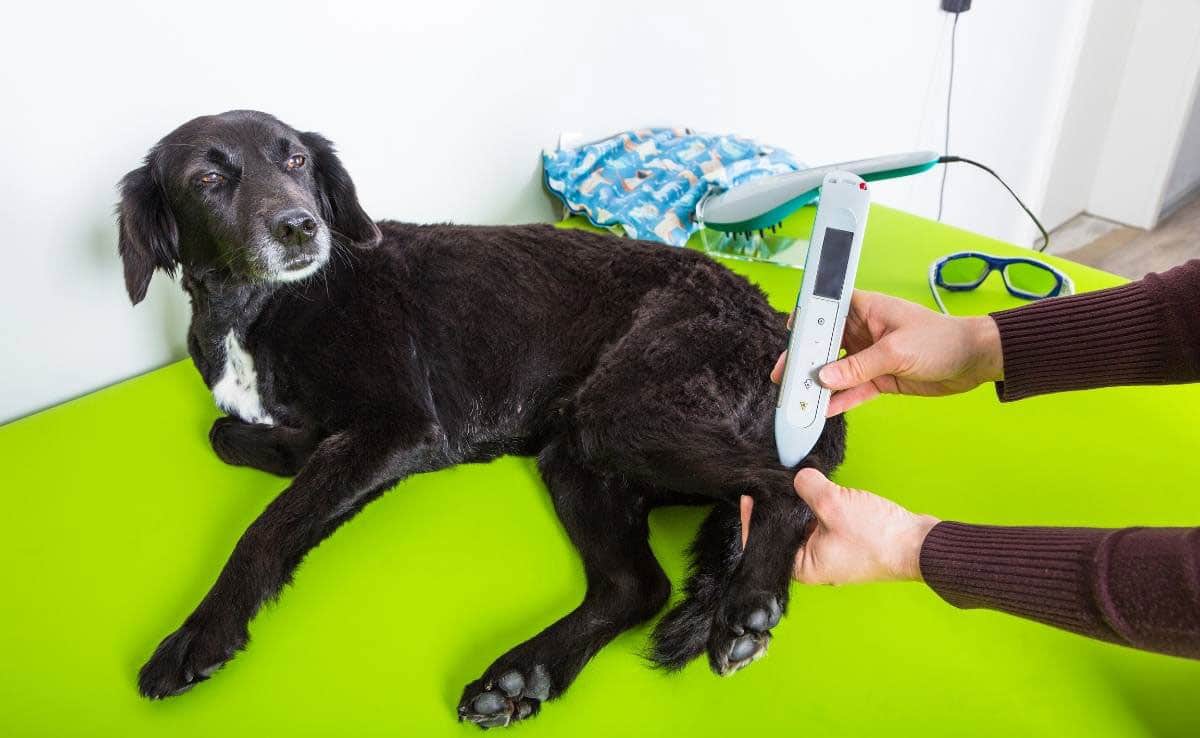
To keep the lights on, we receive affiliate commissions via some of our links. Our review process.
When our pets are in pain or injured, we naturally want to do everything we can to get them back to their usual antics as soon as possible. Laser therapy, sometimes referred to as cold laser therapy, is a procedure that is becoming increasingly popular in veterinary medicine to treat various conditions in dogs. So, what is laser treatment for dogs? How can it help your four-legged friend? And is dog laser therapy safe?

Cold Laser Therapy For Dogs
Contents
Laser therapy has recently gained popularity as an adjunctive treatment in both human and veterinary medicine. Alongside or instead of medications, it can be used to manage pain and inflammation and promote wound healing. Laser treatment has been used alongside other alternative therapies such as acupuncture, massage therapy, and physiotherapy to aid dogs’ recovery from illness and injury.
The word laser is an acronym meaning “light amplification of stimulated emission of radiation.” Lasers are a very focussed beam of light artificially created so that the light waves all have very similar wavelengths. Different classes of lasers exist, and they have many functions in everyday life, from laser printers, bar code scanners, computers, and electronics to those used in medical procedures.
Cold laser therapy, or therapeutic lasers, differs from surgical lasers. Surgical lasers use a higher frequency of light that causes heat injury to tissues to cut and seal vessels during surgical procedures. Cold lasers are also referred to as class III or IV lasers.
How Laser Therapy Works
Laser therapy helps promote the healing of tissue and relieve pain through a process called photobiomodulation. This means that the light emitted by the laser penetrates the cells in the treated area and is converted into useful energy. This energy stimulates cells to release chemicals involved in growth, repair, and proliferation. When the body is healing from injury or inflammation, natural processes occur that increase blood flow to the area, delivering essential chemicals or signals to encourage cells to grow, repair, and divide. Cold laser therapy aims to speed this process up by improving the body’s natural healing mechanisms.
How Laser Therapy Helps Tissue Repair
- Releases endorphins – These are natural chemicals in the body that have many functions, including reducing pain signals.
- Vasodilation – This is the widening of blood vessels which increases blood flow to damaged tissue bringing oxygen and natural healing chemicals.
- Muscle relaxation – The muscles around an injury or an inflamed joint can become stiff and painful to compensate. Relaxation of these muscles improves comfort for dogs.
- Decreasing inflammation
- Promoting cell growth and repair
Conditions Treated By Cold Laser Therapy
Laser therapy has been used to treat several conditions and ailments in dogs. It has been used as a sole treatment, in conjunction with other therapies or medications, or to help heal following surgery in dogs. The most common conditions treated by cold laser therapy in dogs are:
- Chronic arthritis and joint pain
- Surgical incisions, particularly after joint surgery
- Tendon and ligament injuries
- Traumatic injuries and wounds
- Spinal disc disease
Laser Treatment For Arthritis In Dogs
Cold laser therapy can be a beneficial adjunctive treatment for dogs with arthritis. Dogs with osteoarthritis have increased levels of inflammation in the tissues around the joints. Increasing blood flow to the joints and decreasing inflammation help to improve comfort levels for dogs with this chronic condition. It is often used alongside medications or other treatments, such as physiotherapy or hydrotherapy, to help manage arthritis and reduce pain.
Dog laser therapy for arthritis can be beneficial for pets with liver disease or other illnesses that mean they cannot take medications or for those that have experienced side effects with pain medications.
How Is Laser Therapy Performed In Dogs?
Laser treatment is usually a low-stress treatment. Your dog is awake during the procedure, and sedation or restraint is rarely necessary. Most dogs find the experience pleasant, and many just lay down and sleep during the treatment. A handheld laser wand is slowly moved back and forth over the treated area, producing a slightly warming sensation on your dog’s fur. Sessions last up to 30 minutes. The number and frequency of treatments depend on the injury and the type of laser being used.
Dogs often wear protective goggles during the procedure, or an assistant helps direct their eyes away from the laser beam if the area being treated is away from your dog’s head and eyes.
Your dog won’t need time to recover from laser treatment sessions. Some dogs need multiple sessions before results are seen, whereas others show reduced discomfort and increased mobility after just one or two sessions.
Laser Therapy For Dogs’ Side Effects
Cold laser therapy is generally very safe for dogs if performed correctly using the correct frequency and duration. High-frequency units can cause thermal burns to tissue if misused. The biggest danger of laser therapy is retinal damage to anyone who looks directly at the laser beam. The person operating the laser beam and anyone else within a certain radius of the beam should wear protective goggles to prevent damage to their eyes.
At Home Cold Laser Therapy For Dogs
When cold laser therapy was first used in pets, the devices used were mainly sold to veterinary professionals such as veterinary surgeons and physiotherapists. As the technology has become more widespread, some cold laser devices have been marketed for at-home use. There are now many cold laser therapy devices that can be purchased by dog owners for use at home. Cold laser therapy machines for home use for dogs are low-level lasers that deliver a lower frequency of light. They are not as powerful as the class 4 lasers used in veterinary clinics; however, they can still have some of the benefits of cold laser therapy. Class 4 lasers cannot be legally used in a home setting due to health and safety requirements around the laser power beam.
Frequently Asked Questions
How Long Does A Laser Treatment Session Take?
The length of laser treatment depends on the size of the area being treated and the condition being treated. Sessions can be as short as 5 minutes or as long as 30 minutes.
How Many Sessions Will My Pet Need?
This depends on the condition being treated. For acute conditions, one or two treatments may be sufficient. For chronic conditions, such as arthritis or joint pain, treatment is started more frequently (several times per week) and then decreased to weekly booster sessions as required to control pain.
Will Laser Treatment Hurt My Pet?
No. Laser treatment isn’t a painful procedure. The laser device produces a mild warmth, but most pets find this sensation pleasant and relaxing. Areas of acute inflammation, such as surgical sites or wounds, may be sensitive briefly after treatment.
What Is K-Laser Therapy For Dogs?
The K-laser is a brand of medical laser therapy machine that is used to treat humans and animals. They combine four specific wavelengths of light to create a laser that can be used for acute and chronic tissue injury and pain.
What Is The Best Cold Laser Therapy Device For Dogs?
The best cold laser therapies are usually those used by veterinary professionals as these are higher frequency lasers that are ‘stronger’ and have a more profound effect on tissues. However, if you are considering investing in an at-home laser device to aid your dog’s treatment at home, then plenty are on the market. Consult with your veterinary surgeon or physiotherapist for recommendations on the type of laser that would suit your pet’s condition best, how often to treat your pet, and how to use it safely.
Will Laser Therapy Help Your Dog?
Low-level laser therapy, or cold laser therapy, is a form of alternative medicine that can be used in dogs to help treat various illnesses and injuries. It is generally a safe treatment that uses light to penetrate tissues and accelerate the body’s natural healing process. It is a growing tool in veterinary medicine and may be a useful treatment to help manage your dog’s ailments. If you think your dog would benefit from laser therapy, then it is advised to seek veterinary advice before starting to ensure it is the most effective treatment for your canine friend. Learn more about other alternative treatment options, including therapy and acupuncture.
Tagged With: Arthritis